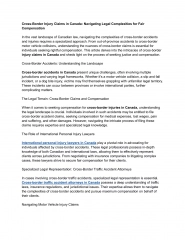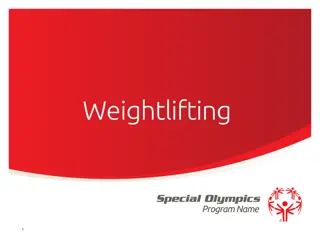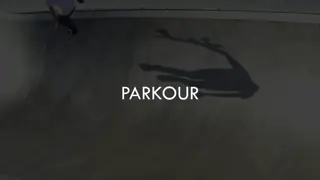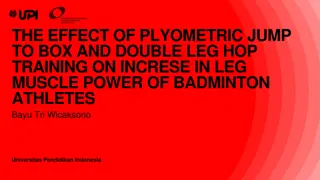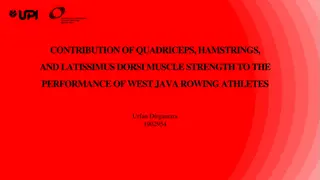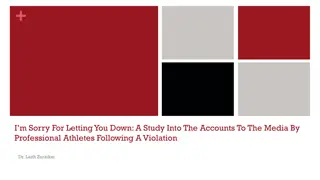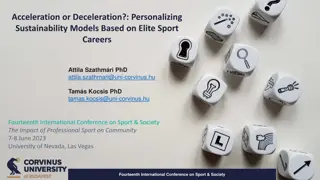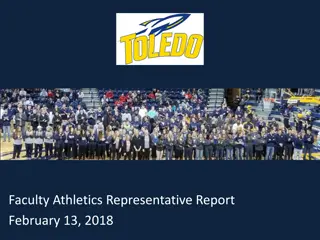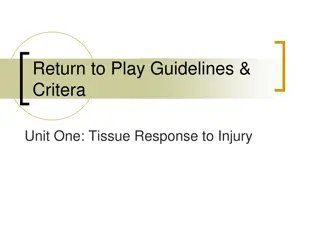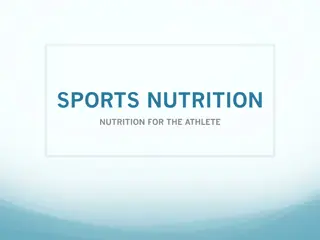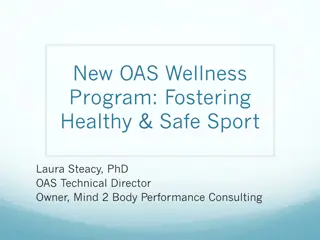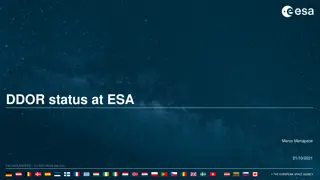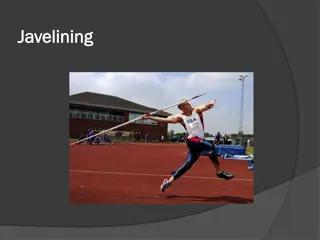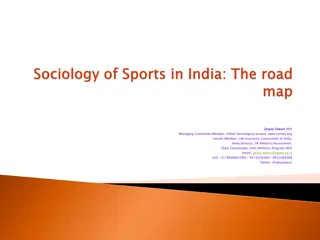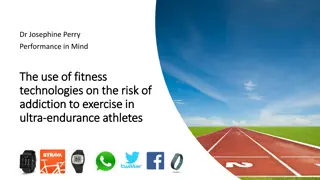Cross-Cultural Comparison of Elite Athletes' Transition Out of Sport
This PhD thesis by Andreas Küttel explores how socio-cultural contexts influence the transition process of elite athletes from Switzerland, Denmark, and Poland. The study aims to compare preconditions, adaptation periods, and long-term consequences of athletic retirement, while identifying factors contributing to the quality of transition. The holistic, culturally sensitive approach sheds light on how national contexts impact athletes' career paths post-sport.
- Elite athletes
- Cross-cultural comparison
- Transition process
- Athletic retirement
- Socio-cultural context
Uploaded on Sep 17, 2024 | 0 Views
Download Presentation

Please find below an Image/Link to download the presentation.
The content on the website is provided AS IS for your information and personal use only. It may not be sold, licensed, or shared on other websites without obtaining consent from the author. Download presentation by click this link. If you encounter any issues during the download, it is possible that the publisher has removed the file from their server.
E N D
Presentation Transcript
PhDDefense A cross-cultural comparison of the transition out of elite sport of Swiss, Danish, and Polish athletes Andreas K ttel Institute for Sports Sciences and Clinical Biomechanics, University of Southern Denmark, Faculty of Health Sciences Odense May 3rd, 2017 1
General introduction Athletic retirement Definition of a transition an event or non-event (which) results in a change in assumptions about oneself and the world, and thus requires a corresponding change in one s behavior and relationships (Schlossberg, 1981, p. 5) Different transitions: athletic/non-athletic normative/non-normative New trends in athletic career transition research Bildergebnis f r athletic retirement 2
Research questions and aims of the project How does the socio-cultural context, including the sports systems of different countries, influence athletes transition processes out of sport and the quality of the adaptation to the post-sport life? Applying a holistic, ecological and culturally sensitive approach to studying the transition out of elite sport, this PhD thesis aimed to: 1) Compare the transition of former elite athletes of Switzerland, Denmark, and Poland in terms of preconditions, adaption period, and long-term consequences of athletic retirement 2) Identify how factors contribute to the quality of the transition depending on the national context 3) Increase the understanding of how the socio-cultural context influences athletes career paths and their transition out of sport 3
Overview of the research project and thesis Literature review Development of the theoretical framework Empirical part 1: Empirical part 2: Survey with former elite athletes from Switzerland, Denmark, and Poland about athletic career, transition period, and consequences of athletic retirement Interviews with dual career experts in Switzerland, Denmark, and Poland; document analyses about athlete career support and dual career programs Paper 1 Paper 3 Paper 2 General discussion and practical implications Figure 1: Overview of the PhD thesis. 4
Theoretical framework The developed Ecological framework to study the transition out of elite sport (Kuettel, 2017) builds on several existing athletic transition and career developmental models: Schlossberg (1981) Taylor and Ogilvie (1994) Stambulova (2003) Wylleman and Lavallee (2004) Stambulova, Stephan, and J phag (2007) It furthermore includes the different interacting levels of the human development (Bronfenbrenner, 1979) which emphasize that an athlete affects and is affected by both the close and the proximal context It encompasses cross-cultural (Hofstede, 1991; 2010) and cultural frameworks (Schein, 1990; 2010) 5
Ecological framework to study the transition out of elite sport (Kuettel, 2017) Macro-level (Country) Welfare system Domestic living standards Cultural dimensions Meso-level (Sports system) Financial support for elite athletes Dual career possibilities for elite athletes Availability/quality of athlete career- and retirement services Mass media attention for sport disciplines Cultural praxis of athletes career paradigm The transition out of elite sport with relevant demands Micro-level (Athletes close environment) Individual characteristics Potential transition resources/barriers Adaptation to the post-sport life Career-end characteristics Quality of the transition Environmental characteristics Athlete as a whole person; holistic lifespan perspective of athletes career Figure 2: Ecological framework to study the transition out of elite sport. 6
Table1: Overview of macro- and meso-aspects of Switzerland, Denmark, and Poland. Aspect Switzerland (CH) Denmark (DK) Poland (PL) Population size (2014) 8.2 million 5.6 million 38.5 million Macro-level GDP/capita (2014) US $ 59,536 US $ 46,000 US $ 24,952 Unemployment rate (2014) 4.5% 6.6% 9.0% Welfare system Liberal Social-democratic Conservative Organization of sport system Dual career typology in higher education Bottom-up Mixed-complementary Top-down Laissez-faire: no formal structure State/NSA as facilitators State-centered approach Athlete career program Both during and after career Both during and after career Only during career Meso-level Athletes supported by the military (2014) 18 Athletes (50% jobs) None, but under discussion Over 100 full-time positions Rankings Olympic Games medal table 33 (Beijing 2008) 6 (Vancouver 2010) 32 (London 2012) 7 (Sochi 2014) 24 (Rio 2016) 30 (Beijing 2008) - (Vancouver 2010) 29 (London 2012) - (Sochi 2014) 28 (Rio 2016) 20 (Beijing 2008) 15 (Vancouver 2010) 30 (London 2012) 11 (Sochi 2014) 33 (Rio 2016) 7
National dimensions of culture Figure 3: National dimensions of culture. Source https://geert-hofstede.com/html; Hofstede, Hofstede, & Minkov (2010). 8
Empirical part 1 Quantitative Survey with former elite athletes from Switzerland, Denmark, and Poland about athletic career, transition period, and consequences of athletic retirement Paper 1 Paper 3 9
Method Cross-sectional research design Athletic Career Termination Questionnaire (ACTQ) based on the Retirement from Sport Survey (Alfermann, Stambulova, & Zemaityte, 2004) Part 1: Life in elite sport Part 2: Transition and adaptational period Part 3: Life after elite sport and biographical data The web-based versions in German, Danish, and Polish were sent out to 703 athletes that retired between 2008-2013 10
Sample Switzerland Denmark Poland Total Athletes included in study 231 86 84 401 Age years at career end (SD) 30.5 (6.3) 30.4 (5.4) 32.7 (5.8) 30.9 (6.0) Gender (female) 31% 34% 37% 33% Amount of sport disciplines 34 25 24 39 Top 3 at OG/ WCS 34% 44% 33% 36% Response rate: 62-65% in all three countries Samples are considered representative of populations of former athletes Sport discipline were grouped according to their popularity (commercialization) and support received from the national sport governing body 11
Paper 1 Factors contributing to the quality of the transition out of elite sports in Swiss, Danish, and Polish Athletes Many factors have been identified that either facilitate or hinder a successful transition (Park, Lavallee, & Todd, 2013) However: Previous studies investigated the relation between potential factors and the transition quality mostly through bi-variate correlations Aims: Measure the quality of the transition in a broad concept Quantify the contribution of factors on the transition quality taking into account that many factors are interrelated Explore whether factors are context-specific or universal applicable 12
Ecological framework to study the transition out of elite sport (Kuettel, 2017) Welfare system Domestic living standards Cultural dimensions Macro-level (Country) Financial support for elite athletes Dual career possibilities for elite athletes Availability/quality of athlete career- and retirement services Mass media attention for sport disciplines Meso-level (Sports system) Cultural praxis of athletes career paradigm The transition out of elite sport with relevant demands Micro-level (Athletes close environment) Individual characteristics Paper 1 Potential transition resources/barriers Adaptation to the post-sport life Career-end characteristics Quality of the transition Environmental characteristics Athlete as a whole person; holistic lifespan perspective of athletes career 13
Athletic career and retirement context Individual characteristics Gender Age Education Sport success Total career income Income from sport Working experience Confidence in skills Athletic identity Popularity (individual) Investments vs. benefits Quality of the transition Outcome: Quality of the transition (component score) Potential resources and barriers Emotional difficulties Social difficulties Health/body difficulties low Financial difficulties Vocational difficulties Short duration of the transition Satisfaction with the transition Transition demands Career-end characteristics 26 explanatory factors Personal/motivational reasons Performance reasons Sport-environmental reasons Job/educational reasons Financial reasons Family reason Health reasons Voluntariness to retire Plans for future Timing Career end as loss vs. relief Environmental characteristics Support private environment Support sport environment Support category of discipline Popularity of discipline Figure 4: Working model of factors contributing to the quality of the transition out of elite sports. (Kuettel, Boyle, & Schmid, 2017) 14
Table 2. Standardized Betas () of Standard Multiple Regression of the 26 explanatory variables on quality of the transition. Switzerland adj. R2=. 26* Denmark adj. R2=.28* Poland adj. R2= .29* -spread Age at career end Gender (1 = female) High education Sport success (top 3) Income from sport in % Total income sport career Working hours while active Confidence in own skills Athletic identity Popularity Investments vs. benefits Personal/motivational reasons Performance reasons Sport environment reasons Job/educational reasons Financial reasons Family reasons Health reasons Plans for future Voluntariness to retire Career end as loss vs. relief Timing career end Support private environment Support sport environment Support category of discipline Popularity of discipline .18 -.06 -.02 .04 .14 -.15 .08 .07 -.09 -.17 .00 -.19 -.04 -.06 -.02 -.11 -.01 -.11 .14 .18 .25 .05 -.02 -.04 -.02 -.02 .05 -.15 -.12 -.15 -.08 -.32 .00 -.12 -.16 .15 -.07 -.21 -.17 .17 -.24 -.07 .22 -.15 -.04 .34 .21 .08 .10 -.01 -.05 .53 .01 -.11 -.01 .03 -.19 .07 .10 .12 -.13 .02 -.07 -.12 -.18 .03 .22 -.12 .17 -.04 -.01 .01 .50 -.08 -.12 -.06 -.09 .30 .17 .09 .11 .18 .33 .39 .10 .24 .07 .32 .07 .09 .14 .24 .47 .05 .23 .09 .18 .32 .29 .13 .22 .05 .10 .56 Individual characteristics Career end characteristics Environmental characteristics 15
Summary of Paper 1 There are various factors that contribute to a successful transition A few common facilitators were identified (e.g., voluntary retirement, positive perception of career end) A few common barriers were identified (e.g., athletic identity, injury, personal/motivational reasons, performance-related reasons) Many factors showed a national specific effect on the transition quality The factors related to the career-end situation have a strong influence on the following transition success It is important to consider the socio-cultural context when studying athletic retirement Kuettel, A., Boyle, E., & Schmid, J. (2017). Factors contributing to the quality of the transition out of elite sports in Swiss, Danish, and Polish athletes. Psychology of Sport and Exercise 29, 27-39. 16
Paper 3 A cross-national comparison of the transition out of elite sport of Swiss, Danish, and Polish athletes Both common and national specific patterns were identified when comparing athletic retirement across nations (e.g., Stambulova, Stephan, & J phag, 2007) However: Cross-national comparisons are sparse and more studies are needed to increase the understanding as to how the socio-cultural context affects athletic retirement (Stambulova, Alfermann, Statler, & C t , 2009) Aims: Compare (a) preconditions, (b) adaptation period, and (c) consequences of the transition of Swiss, Danish and Polish athletes Enhance the understanding of the influence of the national sport system, dual career opportunities and cultural aspects on the transition and the adaptation to post-sport life 17
Ecological framework to study the transition out of elite sport (Kuettel, 2017) Welfare system Domestic living standards Cultural dimensions Macro-level (Country) Financial support for elite athletes Dual career possibilities for elite athletes Availability/quality of athlete career- and retirement services Mass media attention for sport disciplines Meso-level (Sports system) Cultural praxis of athletes career paradigm The transition out of elite sport with relevant demands Micro-level (Athletes close environment) Individual characteristics Paper 3 Potential transition resources/barriers Adaptation to the post-sport life Career-end characteristics Quality of the transition Environmental characteristics Athlete as a whole person; holistic lifespan perspective of athletes career 18
Results Table 3. Individual characteristics compared across Swiss, Danish, and Polish athletes. Switzerland Denmark Poland Effect size (r/V) F/ 2 Item (range) M/p SD M/p SD M/p SD Higher Education 39%a 62%b 85%c 53.27*** .36 Income from sport 46%a 52% 59%b 3.41* .14 Previous work experience (hours) 13.35a 14.12 11.88 13.07 8.50b 11.71 4.03* .14 Confidence in skills (11- 55) 38.97a 9.13 33.35b 8.25 40.88a 7.91 18.26*** .29 Athletic identity (1-7) 5.28a 0.84 5.54 0.81 5.81b 0.88 12.94*** .25 Popularity (1-5) 2.47a 1.12 2.26a 1.22 3.02b 1.13 10.55*** .22 Investments vs. benefits (1-5) 3.18a 1.45 4.22b 1.05 2.86a 1.34 25.20*** .34 Note: Means with different subscripts in a row are significantly different from each other. p < .05. p < .01. p < .001. 19
Educational levels at the end of sports career 70% 60% Switzerland Denmark Polen 50% 40% 30% 20% 10% 0% 9/10 years schooling vocational education gymnasium technical college bachelor master/phd 20
Training, work, and study while active in elite sport 25 23 20.9 20 20.1 Switzerland Denmark Poland 15 13.4 13.4 11.9 11 10 10.6 8.9 8.5 7.4 6.7 5 0 * * * * training hours additional training effort work besides study besides * Differences significant at the .05 level 21
Table 4. Adaptation period compared across Swiss, Danish, and Polish athletes. Switzerland Denmark Poland Effect size (r) Item (1- 5) M SD M SD M SD F 3.69* Emotional difficulties 2.76a 1.33 3.20b 1.32 3.01 1.34 .13 5.91** Social difficulties 2.43a 1.19 2.92b 1.34 2.79 1.30 .17 5.19** Health/body difficulties 2.00a 1.17 2.41b 1.22 2.38b 1.31 .16 Vocational/educational difficulties 8.30*** 1.81a 1.14 2.01 1.09 2.40b 1.20 .20 26.91*** Financial difficulties 1.71a 1.01 1.88a 0.98 2.75b 1.38 .35 Satisfaction with the transition Duration of adaptation (in months) 45.19*** 4.45a 0.65 4.45a 0.62 3.61b 0.97 .43 9.23 8.95 10.44 8.33 9.05 9.05 0.70 .06 Note: Means with different subscripts in a row are significantly different from each other. p < .05. p < .01. p < .001. 22
Table 5. Job/life situation after the elite sports career compared across countries. Switzerland Denmark Poland Effect size (r/V) F/ 2 Item (1- 5) M/p SD M/p SD M/p SD Job(s) connected to sport 42.70** 35% 31% 74% .33 Current job/life situation 4.49 Self-employed 21% 21% 32% .11 Satisfaction with current job situation 11.51*** 4.37a 0.89 3.87b 1.36 3.88b 0.96 .24 17.21*** Life satisfaction (1-7) 5.52a 0.87 5.53a 1.04 4.84b 1.06 .28 Own personality 4.31 0.79 4.42 0.86 4.13 0.97 2.51 .01 Reasons for finding Skills and knowledge learnt in sports 3.96 1.16 4.09 1.13 4.35 0.89 3.83* .14 current job(s) Former education 3.96 1.25 4.07 1.21 4.01 1.16 .027 .00 18.46*** Popularity/status 2.47a 1.41 2.44a 1.39 3.54b 1.48 .30 Connection to clubs and federations 7.21*** 2.39a 1.50 2.25a 2.32 3.04b 1.59 .20 Note: Means with different subscripts in a row are significantly different from each other. p < .05. p < .01. p < .001. 23
Summary of Paper 3 Many differences were found among the individual characteristics (i.e., the variables related to the life in elite sport) The majority of athletes mastered the transition successfully Polish athletes reported a higher distress in the adaptation period and expressed also a lower life quality in the situation after elite sport Different (national) patterns were identified how former athletes relocate to the labor market Kuettel, A., Boyle, E., Christensen, M. K., & Schmid, J. A cross-national comparison of the transition out of elite sport of Swiss, Danish, and Polish athletes. Under review in Sport and Exercise Psychology Review. 24
Empirical part 2 Qualitative Interviews with dual career experts in Switzerland, Denmark, and Poland; document analysis about athlete career support and dual career programs Paper 2 25
Ecological framework to study the transition out of elite sport (Kuettel, 2017) Welfare system Domestic living standards Cultural dimensions Macro-level (Country) Financial support for elite athletes Dual career possibilities for elite athletes Availability/quality of athlete career- and retirement services Mass media attention for sport disciplines Meso-level (Sports system) Paper 2 Cultural praxis of athletes career paradigm The transition out of elite sport with relevant demands Micro-level (Athletes close environment) Individual characteristics Potential transition resources/barriers Adaptation to the post-sport life Career-end characteristics Quality of the transition Environmental characteristics Athlete as a whole person; holistic lifespan perspective of athletes career 26
Paper 2 A cross-cultural comparison of the dual career environment for elite athletes in Switzerland, Denmark, and Poland Dual career programs vary strongly across national contexts (e.g., Aquilina & Henry, 2010; De Bosscher et al., 2015; Ryba & Stambulova, 2013) However: Impact of the dual career environment on athletes career trajectories and their transition out of sport is little researched Aims: To give an overview of the available dual career programs in Switzerland, Denmark, and Poland To highlight the commonly taken dual career pathways of elite athletes in these three countries To enhance the understanding of the cultural embeddedness of dual career programs and the respective dual career trajectories of athletes 27
Method Semi-structured interviews Four dual career experts were interviewed in all three countries National Sports Governing Body or Olympic Federation A Higher Educational Institution where elite athletes are enrolled A well-recognized Sports Federation A Career Counselor from an Athletes Career Program Document analysis Official documents of the national elite sports agency Guidelines for student-athletes at universities Reports about athlete career programs Papers about talent development programs Websites of federations and national elite sport bodies SPLISS reports of Denmark and Switzerland, collection in Poland (De Bosscher et al., 2015) 28
. Comparison of dual career environments Cross-cultural comparison of dual career environments for elite athletes Switzerland Denmark Poland Dual career environment for elite athletes Dual career environment for elite athletes Dual career environment for elite athletes Education Education Education Job Job Job Skills Skills Skills CAPs CAPs CAPs Accounts of the four interviewed experts Accounts of the four interviewed experts Accounts of the four interviewed experts Figure 5: The embedded multiple-case study design to compare the dual career environments for elite athletes in Switzerland, Denmark, and Poland (Kuettel, 2017). 29
Table 6: Cross-cultural comparison of dual career environment for athletes. Switzerland Label and partner schools Denmark Sports classes (gymnasium) Poland Master classes Lower education Typology of dual career (Aquilina & Henry, 2013) Higher education State/NSA as facilitator State/NSA as facilitator State-centered Only individual solutions No institutionalized service Established service at 3 out of 4 universities Individual study programs at physical education study No financial support for athletes Financial support for students Financial support (stipend) Typology of dual career Laissez-faire Dual career is responsibility of each athlete State/NSA as facilitator Develop athletes in a social responsible way State-centered Develop athletes to be successful in sport Espoused Values Athletes need to find solutions in the given system Should be possible to study all kind of subjects Choice of study is dictated by the system Dual career can improve or decrease athletic performance Combining sport and education makes athletes more successful Education should not distract athletes from the sporting performance Basic assumptions Typology of dual career trajectory (Pallar s et al., 2011) Convergent Parallel Linear 30
Some quotes / espoused values If you REALLY want to be successful, then it is hardly possible to take an education. Swiss Olympic also supports such a decision. We would be the last ones forcing athletes into an education. Our attitude is: Try to take an education, but we are aware that in certain sports it is necessary to give everything you ve got and go all in on the sport. Athletes can catch up on education later on. Our attitude is that education is a duty if one would express it a bit exaggerated. If a player does not want to take an education, he can actually not play in the national team. For us, it is really important to create the whole person. To create the whole person, one needs to be educated. This is how it goes through generations. It is the same path [ ] this is the pathway of an athlete. If you are an elite athlete, it is the easiest way to go to AWF (Physical Education Academy) and later become a coach or a physical education teacher, or someone still connected to the sport. 31
Summary of Paper 2 Dual career programs and opportunities vary especially on tertiary education between Switzerland, Denmark, and Poland Different underlying assumptions about how to combine elite sport with education are rooted in the three contexts. These assumptions seem to be related to the welfare ideologies in the respective country Athletes dual career trajectories are influenced by the sport and educational system as well as the broader socio-cultural context Kuettel, A., Christensen, M. K., Zysko, J., & Hansen, J. A cross-cultural comparison of the dual career environment for elite athletes in Switzerland, Denmark, and Poland. Manuscript submitted to the Journal of Applied Sports Psychology. 32
General discussion Career transition out of elite sport is a complex and multifaceted phenomenon Individual characteristics of an athletes, the situational circumstances of the career end, and the proximal and peripheral context play a role in the adaptation process to the post-sport life Athletes careers are infused by the socio-cultural context and demand researches and practitioners reflexivity and cultural praxis Limitations 33
Recommendations for athletes career assistance A whole career approach to help athletes cope with both normative and non-normative transitions throughout the whole course of an athletic career A whole person approach to help them deal with transitions in various spheres of life An individual approach to accommodate the athletes perceptions of the transition and their distinctive resources and barriers for the transition(s) A transferable skills approach to teach athletes life skills that are applicable both in and outside sport and in the athletic and post-athletic career A cultural-specific approach to help athletes adjust within a particular sports system, society, and culture 34
Recommendations for future research Include culture not only as a mediator variable when comparing athletes careers or elite sport/ dual career systems across national contexts Investigate influence of athletes educational level on job seeking strategies Evaluation of Career Assistance Programs for athletes 35
And finally Lessons learnt Reflexivity Dual career Mixed-method approach Transition what`s next? Thanks to Team Denmark, the Danish Ministry of Culture, the Fritz B sch Foundation, and the Health Faculty of SDU for supporting this PhD project! 36
PhDDefense A cross-cultural comparison of the transition out of elite sport of Swiss, Danish, and Polish athletes Andreas K ttel Thank you for your attention! Institute for Sports Sciences and Clinical Biomechanics, University of Southern Denmark, Faculty of Health Sciences Odense May 3rd, 2017 akuttel@health.sdu.dk 37



